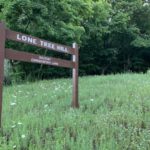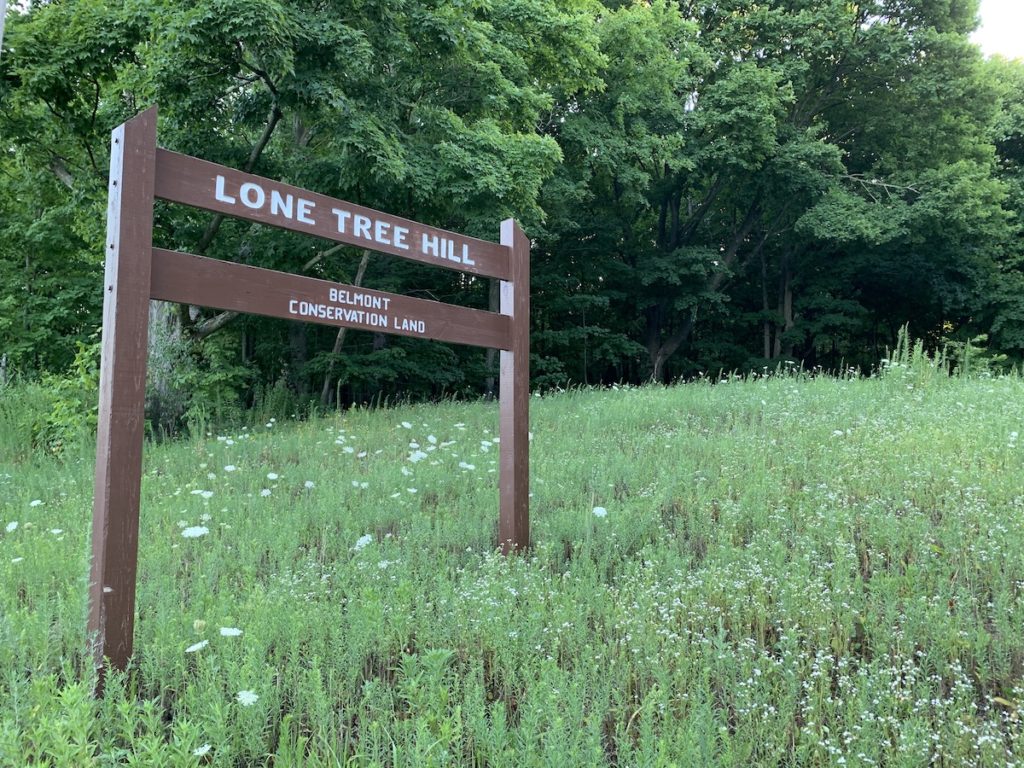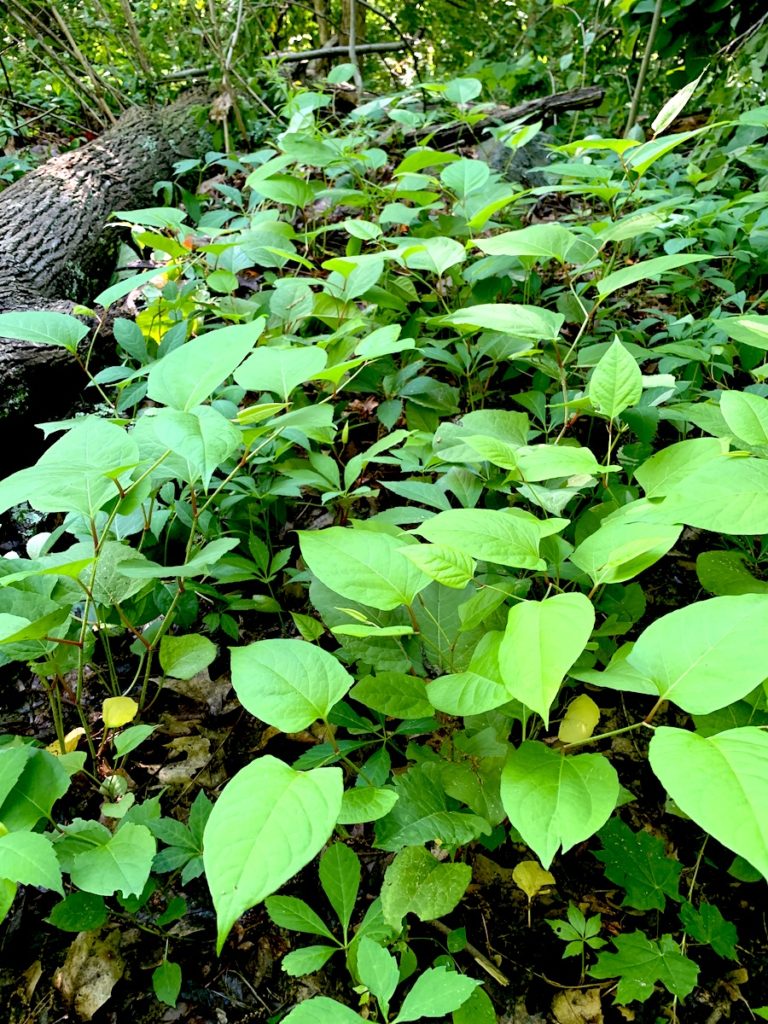
By Dean Hickman and Leonard Katz
Between Pleasant Street and Trapelo Road to the south, Concord Avenue to the north, and Mill Street to the west, Lone Tree Hill wraps around McLean Hospital and sits above Belmont, providing us with a peaceful and secluded mix of woods and meadows where we can escape the hustle and bustle of suburban life down below. It is also Belmont’s gateway to Rock Meadow on the other side of Mill Street as well as to the more secluded trails of the Western Greenway which head west into neighboring Waltham and Lexington.
Anyone looking for a break, or a peaceful place to walk and think, would do well to take the short walk into these woods and beyond. Arguably the best time to experience this Belmont wonder is the cool early morning at first light before the distant hum of traffic and gardening equipment takes some of the magic of Lone Tree Hill’s quiet nature away. However, at any time of day you will find the air healthier and 10 degrees cooler, thanks to the tree cover and meadows which you don’t find in the urban environment below.
Many more people have come to appreciate this public space since COVID-19 gripped society in 2020. While attending the Belmont Citizens Forum’s 8th Lone Tree Hill Volunteer Day last April, mostly to remove the trash which routinely pollutes the roadside and verge along Pleasant Street and defies gravity by blowing up the Coal Road, I met Leonard Katz. Leonard is a person I can only now describe as a guardian of Lone Tree Hill.
A Belmont resident and associate at Harvard University’s Philosophy Department, Leonard came to the same event, but with a different purpose. He was leading volunteers in removing invasive plants.
Eager to learn more and to help with Leonard’s mission, I joined a smattering of other volunteers on subsequent Saturday mornings under the direction of the Land Management Commission to remove invasive non-native plants from Lone Tree Hill. We learned that many of these plants, with their prolific seeds, deep roots, and no natural adversaries, crowd out native plants or poison the fungi the native plants depend on by secreting chemicals into the soil. Removing them helps native Massachusetts plants thrive and take back the land where they evolved, providing native insects and pollinators the food they need to survive and us residents a natural oasis adjacent to where we liv.
When I asked Leonard about his journey to the present-day guardian of Lone Tree Hill, he responded:
“As a teenage hiker and for years later, I used trails others built and maintained, through landscapes and forests others protected. Except for occasional minor unplanned trail clearing efforts that were incidental to my hiking, I didn’t do my share, except for a single Sierra Club service trip working on California wilderness trails.
“This changed in the past decade as I gradually took responsibility for my neighborhood woods. Walking up Lone Tree Hill’s Coal Road trail, I found I couldn’t pass through the quasi-clearing near the seasonal stream crossing between trail markers nine and 10 without brushing Japanese knotweed stems on both sides. This endangered walkers and bikers who might unwittingly pick up ticks. So I didn’t just pass by but broke off every trail-encroaching stem.
“Soon I realized that a drought was causing a die-back of other knotweed stems, which ordinarily flower and then seed in late summer before dying back to their underground rhizomes at first frost. This offered an opportunity to go after the rest of the knotweed patch when it was weakened by drought.
“I received permission from Lone Tree Hill’s Land Management Committee and, that year and later, removed much of it, allowing the native shrubs that had been overtopped by towering annual knotweed growth their place in the sun. This allowed regrowth of the carbon-storing three-tier tree/shrub/herbal ground cover native forest in this disturbed area of an otherwise largely intact ecosystem, into which the invasive knotweed was starting to spread.
“I originally had nothing against Japanese knotweed or European garlic mustard. I even enjoyed eating them seasonally. Only later did I learn that garlic mustard poisons the underground fungi that feed needed minerals to trees and also to the trout lilies that I love. Such invasive plants impair the biodiversity of our native plant and wildlife communities, in which plants feed local insects and other wildlife.
“Last spring the Land Management Committee resumed permission for my work on invasive plants. I Ied volunteers on Saturday mornings, mainly removing garlic mustard from areas near the boundary of Lone Tree Hill and Rock Meadow, near Mill Street. While I’ve done some work on knotweed recently, I’m waiting for soaking rains to lubricate the roots and rhizomes to enable pulling this out efficiently, while drought once more helps by causing knotweed stems to die this year.
“Sustaining and continuing this work of monitoring and removing regrowth will need others participating and eventually taking over, doing our parts toward a sustainable Belmont in which humans and native plants each have their parts to play locally in maintaining a livable planet. But this work is also immediately rewarding in the moments of peace in nature that we experience in getting to notice and love close-up our native flowers, ferns, shrubs, and seedling trees, which we would otherwise miss, as those of us who steward our conservation land learn to do.”
If you would like to learn more about native plants in our local woodland and get involved you can sign up at bit.ly/BCF-LTH-Form to join a growing group of volunteers in our community restoring and advocating for Lone Tree Hill conservation area.
Dean Hickman is chair of Sustainable Belmont, a nonprofit organization that educates and advocates on environmental issues for Belmont. Leonard Katz serves on the Invasives Working Group of the Land Management Committee for Lone Tree Hill.




Sorry, the comment form is closed at this time.